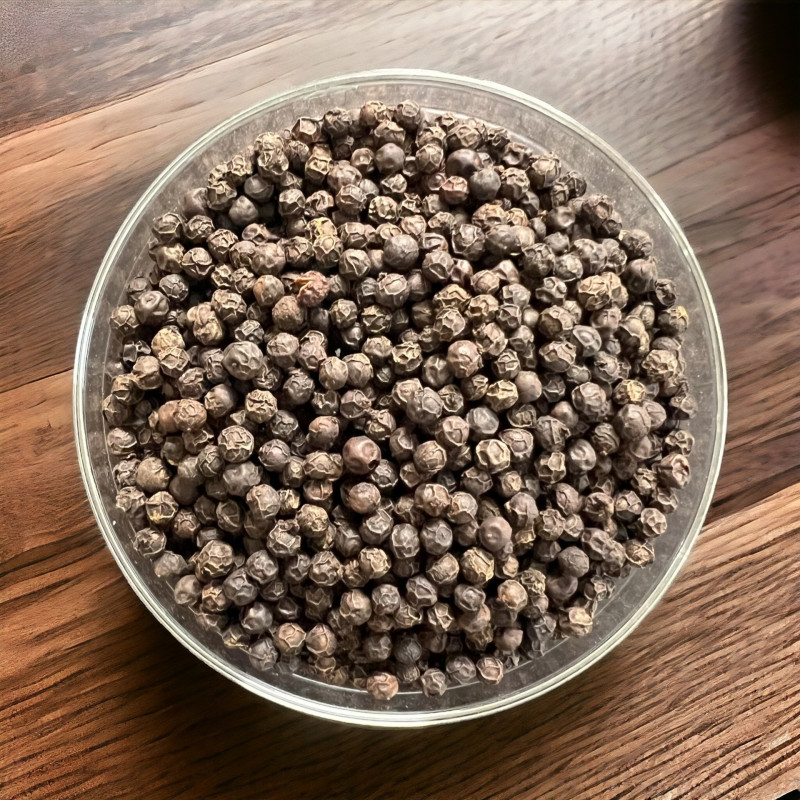- Reduced price




A product from a PGI that includes responsible farming practices.
One of the best peppers in the world, hand-harvested!
 Delivery
Delivery
Mondial Relay
 Returns
Returns
See conditions
 Payments
Payments
100% secure
Livré en sachet refermable
Uses in Cooking:
Kampot pepper develops both strong and delicate aromas on the palate, with floral, fruity, and very fresh notes, accompanied by a hint of eucalyptus and fresh mint.
As Cambodia’s iconic pepper, its fruity taste and aromatic notes of dried fruits make it particularly suitable for grilled meats, salads, and fish! Furthermore, like all exceptional peppers, it remains very versatile and will add an original and powerful note to good red meat, game, or any other dish! However, avoid long cooking times that may render it bitter!
My Advice: As an exceptional pepper, do not mix it with other peppers to fully enjoy all its aromas, much like a fine wine! Grind it with a mill or crush it in a mortar as needed to preserve its fresh flavor!
Who am I?
Origin: Cambodia
Scientific name: Piper nigrum
The black peppercorns from Kampot are hand-harvested starting in February and are then sun-dried for 2 to 3 days.
It is emblematic of its country of origin (like the red Kampot pepper), and it is this terroir that gives it such a particular flavor, akin to fine wines. This pepper is actually the very first Cambodian agricultural product to obtain a PGI (Protected Geographical Indication).
These grains are relatively large, between 4 and 5 mm in diameter, and quite smooth.
Like all worthy peppers, Kampot pepper comes in four different colors:
Green: Only found fresh on-site in Cambodia, harvested starting in September.
Black: The berries are picked almost ripe, slightly reddish, and will turn black as they dry. This pepper will develop more spiciness and intensity.
Red: It is harvested during the dry season, usually in March. At this point, the seeds have reached full maturity and after transitioning from green to yellow, they finally achieve their beautiful red color. The pepper is then handpicked, leaving the under-ripe berries on the plant to be harvested later. It is then washed, blanched, and sun-dried for several days. This process allows it to develop its remarkable dried fruit notes, making it particularly interesting. This is my preferred stage for this extraordinary pepper!
White: This is actually red pepper (the ripest) that is first quickly dried and then the skin (pericarp) is removed by soaking and washing, leaving only the seed's core. It is dried again to preserve it.
Kampot pepper nearly disappeared during the Khmer Rouge period. The revival of its cultivation has been slow and laborious, partly due to competition from lower-quality peppers produced in neighboring countries.
A Little History:
Pepper cultivation in Cambodia is very ancient, with traces found in writings from the 13th century. In the late 19th century, its cultivation experienced a boost, favored by French colonial authorities. However, production stagnated due to protectorate policies that imposed prohibitive tariffs to limit its export to the metropolis, favoring pepper from French colonists in Cochinchina.
But the worst came in 1975, when the country fell under the Khmer Rouge. The cultivation of pepper was on the brink of complete extinction, surviving only thanks to the determination of a few farming families who took up the torch.
Today, fortunately, Kampot pepper is gradually regaining its rightful place!
Data sheet
Specific References
 Olivier N.
Olivier N.
Parfait
 Sylvie A.
Sylvie A.
Sans goût
 Hugues R.
Hugues R.
Très bien aussi. Incroyable saveur.
 Céline M.
Céline M.
Super produit. J adore !!
 Michel R.
Michel R.
A peine arrivé, je l'ai simplement dévoré des yeux (enfin le parfum plait!).

 Olivier N.
Olivier N.
Parfait
 Sylvie A.
Sylvie A.
Sans goût
 Hugues R.
Hugues R.
Très bien aussi. Incroyable saveur.
 Céline M.
Céline M.
Super produit. J adore !!
 Michel R.
Michel R.
A peine arrivé, je l'ai simplement dévoré des yeux (enfin le parfum plait!).

Reference: 10N7699901
Reference: 6N745801
Reference: poivrevoatsE
Reference: Graineparadis
Reference: poivresichuanE
Reference: pimentjamaiqueE
Reference: baieroseE
Reference: poivrevoatsE
Reference: 6L5609802
Reference: 508207101
Reference: 6N745801
Reference: poivreNEmada
Reference: poivreBEviet
Reference: 208029701


A product from a PGI that includes responsible farming practices.
One of the best peppers in the world, hand-harvested!